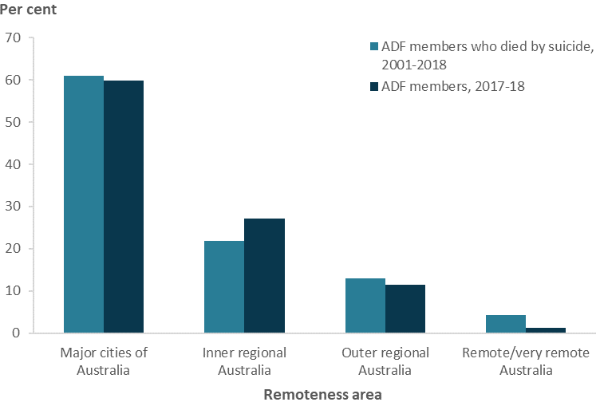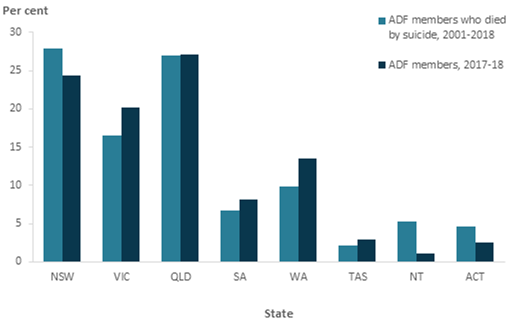Socioeconomic status and selected demographics
On this page:
Key points
- ADF members (serving, reserve and ex-serving) who died by suicide between 2001 and 2018 were less likely to be married or in de‑facto relationships than the 2017−18 ADF population (40% compared with 72%) and more likely to be never married (39% compared with 12%).
- 21% of ADF members who died by suicide were unemployed at time of death compared with 1% of the alive ADF population in 2017−18.
In this chapter, the sociodemographic characteristics of ADF members with at least one day of service between 1 January 2001 and 31 December 2018 who died by suicide are compared with those of all ADF members as measured by the ABS 2017–18 National Health Survey (NHS) data (ABS 2019a) as the most up to date source of information on this population. It must be noted, however that the ADF population as measured by the NHS is older than the post 2001 population, with median age of 60.6 years compared with 38 years. Data from the National Coronial Information System (NCIS) for those deceased in the period 2001 to 2018, are used for the analysis of socioeconomic characteristics of ADF members who died by suicide.
Marital status
Among ADF members who died by suicide, 40% of ADF members who died by suicide were married or in de‑facto relationships at the time of death, 39% were never married, and around 21% were divorced, separated or widowed (Table 8). In comparison, the National Health Survey (NHS) estimates that of alive ADF members, who may have been serving or ex-serving at time of interview, nearly three quarters were married or in de‑facto relationships (72%), 1 in 8 (12%) was never married, and 1 in 6 (17%) was divorced, separated or widowed (ABS 2019a).
Socio-economic characteristics
Country of birth
Most members of the study cohort (88%) who died by suicide were known to be born in Australia with 1 in 8 (12%) known to be born overseas (Table 8). Similarly, in 2017–18, a small proportion of alive ADF members were born overseas: an estimated 1 in 7 (14%) (ABS 2019a).
Employment status
Around 3 in 5 (68%) ADF members (serving, reserve and ex-serving) who died by suicide were employed at the time of death, 1 in 5 (21%) was unemployed, and around 1 in 10 (11%) was not in the labour force (Table 8). By comparison, among alive ADF members (serving, reserve and ex-serving) in 2017–18, an estimated 54% were employed, only 1% were unemployed, and the remaining 44% were not in the labour force (ABS 2019a). The higher median age of the alive ADF members, compared with those who died by suicide, may contribute to differences in employment status, such as the estimated proportion of alive ADF members not in the labour force.
|
|
ADF members who died by suicide, 2001─2018 |
Alive ADF members, 2017─18 |
||
|---|---|---|---|---|
|
|
Number |
Proportion (%) |
Estimates (‘000) |
Proportion (%) |
|
Employment status(a) |
||||
|
Employed |
287 |
67.8 |
381.3 |
54.2 |
|
Unemployed |
90 |
21.3 |
6.3 |
0.9 |
|
Not in labour force |
46 |
10.9 |
309.4 |
44.0 |
|
Total with employment status |
423 |
100.0 |
703.4 |
100.0 |
|
Marital status(b) |
||||
|
Divorced/Separated/Widowed |
84 |
21.2 |
117 |
16.6 |
|
Married/De facto |
159 |
40.1 |
503.6 |
71.6 |
|
Never married |
154 |
38.8 |
84.8 |
12.1 |
|
Total with marital status |
397 |
100.0 |
703.4 |
100.0 |
|
Country of birth(c) |
||||
|
Australia |
382 |
87.6 |
593.8 |
84.4 |
|
Other countries |
54 |
12.4 |
99.2 |
14.1 |
|
Total with COB |
436 |
100.0 |
703.4 |
100.0 |
|
Total(d)(e) |
461 |
|
703.4 |
|
Notes:
- Excludes 1 NCIS case in which employment status was unable to be categorised and 37 NCIS cases (8%) in which it was recorded as unlikely to be known. 'Not in labour force' includes NCIS categories 'Home duties', 'Retired/Pensioner' and 'Student'. ADF members who died by suicide include those who were currently serving, reserve, or ex-serving with at least 1 day of service in the ADF between 1 January 2001 and 31 December 2018. ADF members who were ex-serving may have been unemployed at the time of death.
- NCIS data on marital status is recorded as unlikely to be known in 64 cases (14%).
- This field is determined from the Country of Birth and Place of Birth fields in the NCIS. For 25 (5%) cases it was unlikely to be known from information provided to the coroner whether they were born in Australia or overseas.
- A total of 461 ADF member who died by suicide were included in this analysis as 4 ADF suicide cases were not able to be identified in the NCIS. See technical notes.
- The numbers of alive ADF members in this table have been randomly adjusted to avoid the release of confidential data, and the individual categories may not add to the total. Figures for alive ADF members are estimated from those people who responded to the 2017─18 NHS, and identified as having served in the ADF. This cohort will include ADF members who served and separated prior to 2001. Alive ADF members who were ex-serving may have been unemployed at the time of the survey.
Source: AIHW analysis of NCIS data, 2001–2018; and ABS 2019a.
Usual residence
Most (61%) ADF members who died by suicide lived in major cities. Only a small proportion lived in remote or very remote areas (4% altogether) (Figure 9). Similarly, the majority of alive ADF members in 2017–18 lived in major cities (60%) with a small proportion living in remote areas (1%) (ABS 2019a) (Figure 9).
Figure 9: Remoteness of usual residence(a), proportion of ADF members who died by suicide(b), 2001 to 2018, and ADF members(c) in 2017─18

Notes
- Remote/Very Remote areas of Australia are combined for the NCIS data and very remote areas are excluded in the 2017─18 NHS. See ABS 2017─18 NHS for more information.
- AIHW analysis of NCIS data was used to determine the usual residence of ADF members who died by suicide. A total of 461 ADF members who died by suicide were included in this analysis as 4 ADF suicide cases were not able to be identified in the NCIS. See technical notes. NCIS data on remoteness was missing in 21 cases.
- NHS data were used to determine ADF members’ usual residence. The numbers of alive ADF members in this figure have been randomly adjusted to avoid the release of confidential data, and the individual categories may not add to the total. ADF members from the 2017─18 NHS may include ADF members who served and separated prior to 2001.
Sources: AIHW analysis of NCIS data, 2001-2018; ABS 2019a.
More than half of the ADF members who died by suicide usually resided either in New South Wales (28%) or in Queensland (27%) (Figure 10). Similarly, the majority of alive ADF members in 2017–18 lived in NSW (24%) or in Queensland (27%) (ABS 2019a).
Figure 10: State of usual residence(a)(b), proportion of ADF members who died by suicides, 2001 to 2018, and ADF members 2017─18

Notes
- AIHW analysis of NCIS data was used to determine the usual residence of ADF members who died by suicide. A total of 461 ADF members who died by suicide were included in this analysis as 4 ADF suicide cases were not able to be identified in the NCIS. See technical notes. NCIS data on State of residence was recorded as not applicable in 2 cases.
- NHS data were used to determine ADF members’ usual residence. The numbers of alive ADF members in this figure have been randomly adjusted to avoid the release of confidential data, and the individual categories may not add to the total. ADF members from the 2017─18 NHS may include ADF members who served and separated prior to 2001.
Sources: AIHW analysis of NCIS data, 2001-2018; ABS 2019a.


